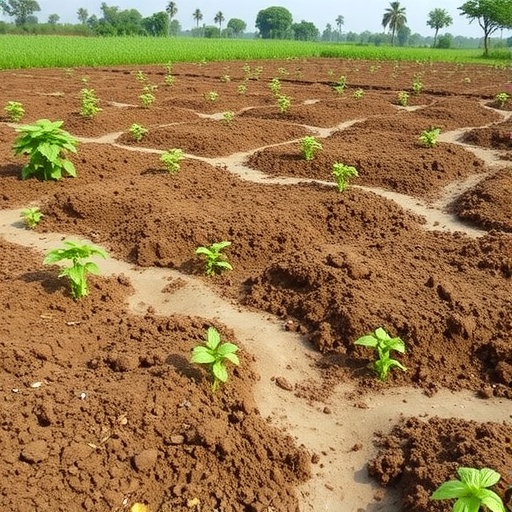In the heart of India’s eastern plateau, a groundbreaking study has emerged that could redefine agricultural practices not just regionally but globally. With the world grappling with the dual crises of food security and environmental sustainability, the research by Abshiba, Chaudhary, Sinha, and colleagues delves deep into soil quality within diversified agricultural systems—a domain often overlooked but critical to long-term ecological balance and productivity.
The eastern plateau of India represents a complex agro-ecological zone where traditional farming practices intersect with modern pressures and climate variability. This study intricately analyzes how diversification in cropping patterns influences soil health, providing a nuanced understanding of practices that sustain, or even enhance, soil quality in a region prone to degradation. Soil, often dismissed as a mere substrate, is unveiled here as a living, breathing entity whose vitality underpins the entire agricultural economy and ecosystem services.
The researchers deploy a comprehensive suite of soil quality indicators, covering physical, chemical, and biological aspects. They examine variables such as soil texture, moisture dynamics, nutrient availability, organic carbon content, microbial activity, and aggregate stability. This multi-faceted approach illuminates the subtle yet profound ways in which diversified cropping strategies modulate these parameters over time, setting a new benchmark for soil health assessments.
One of the standout revelations of the study is the marked improvement in soil organic carbon content in plots where diversified cropping was practiced, compared to monoculture systems. Organic carbon is a critical determinant of soil fertility and resilience against erosion. Its augmentation through diversification is linked not only to enhanced carbon sequestration, vital for mitigating climate change, but also to improved moisture retention and nutrient cycling within the soil matrix.
Furthermore, the biological dimension of soil quality garnered significant attention. The study meticulously chronicled microbial biomass and enzymatic activities essential for nutrient transformation. Findings suggest that diversified systems foster richer and more diverse microbial communities, which in turn accelerate key biochemical processes such as nitrogen fixation and phosphorus solubilization. These microbial enhancements translate into sustainable nutrient supply chains within the soil, reducing reliance on synthetic fertilizers.
Physical soil properties—often the unsung heroes of agricultural productivity—also showed positive shifts. Improved soil structure and aggregate stability were correlated with crop diversification, reducing compaction and susceptibility to runoff. This structural improvement not only enhances root penetration and aeration but also buffers against the increasingly erratic rainfall patterns attributed to climate change, thus safeguarding crop yields.
The research goes further to contextualize these improvements within socio-economic realities. By integrating diversified cropping, smallholder farmers could not only bolster the soil’s health but also reduce economic risk through varied income streams. This dual ecological and economic resilience underscores diversification as a viable strategy to confront vulnerabilities endemic to the plateau’s agrarian landscape.
Detailed statistical analyses validated the significance of these soil improvements, underscoring that diversification’s benefits are not incidental but reproducible and scalable. The study’s robust design included comparisons across multiple seasons and cropping sequences, providing a resilient data set that accounts for temporal variability and climatic influences.
Importantly, the research highlights the role of indigenous knowledge in shaping diversified practices. Traditional rotation methods, intercropping, and agroforestry arrangements endorsed by local farmers are shown to confer advantages that modern intensification often neglects. Such findings advocate for a synthesis of tradition and innovation in designing sustainable agricultural models.
Amid the urgent global discourse on regenerative agriculture, the results from India’s eastern plateau bolster arguments for agricultural diversification as a cornerstone of sustainability. This study situates soil quality at the epicenter of such strategies, promoting policies that incentivize diverse cropping to harmonize agricultural productivity with environmental stewardship.
The implications extend beyond regional confines. With soil degradation threatening 33% of the world’s land and agricultural lands being the frontlines of this crisis, the insights presented here contribute powerful evidence in favor of diversification as a universal principle. Countries worldwide facing similar ecological challenges may find a blueprint in this comprehensive framework.
As climate scenarios forecast increased stress on water resources, soil, and ecosystems, the study’s finding—that diversified agriculture enhances soil moisture retention and nutrient cycling—could be pivotal in ensuring food security. It positions soil not just as a passive resource but as an active participant in climate adaptation strategies.
Researchers also advocate for integrating advanced sensor technologies and remote sensing with traditional field assessments for ongoing soil quality monitoring. This hybrid approach could unlock real-time, scalable insights, facilitating better management decisions and policy formulations grounded firmly in empirical evidence.
In conclusion, this seminal research reiterates the indispensable relationship between crop diversification and soil health, spotlighting the eastern plateau of India as a dynamic testbed for sustainable agriculture. The study’s comprehensive interrogation of soil properties offers a beacon of hope and a strategic roadmap for global agricultural systems seeking to be resilient, productive, and in harmony with the planet.
This groundbreaking work stands as a clarion call for farmers, agronomists, policymakers, and environmentalists alike to embrace diversity—not merely as an agricultural tactic but as a fundamental ecological principle that can shape the future of food systems worldwide.
Subject of Research:
Soil quality assessment in diversified agricultural systems in the eastern plateau of India.
Article Title:
Soil quality in diversified agricultural systems: eastern plateau of India.
Article References:
Abshiba, K., Chaudhary, M., Sinha, N.K. et al. Soil quality in diversified agricultural systems: eastern plateau of India. Environ Earth Sci 84, 566 (2025). https://doi.org/10.1007/s12665-025-12572-y
Image Credits: AI Generated




